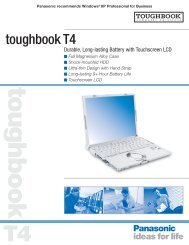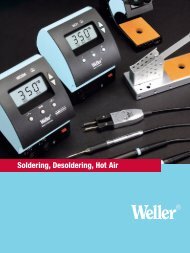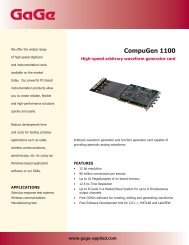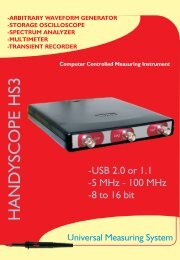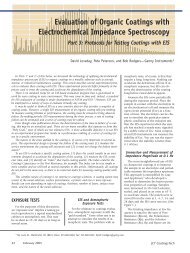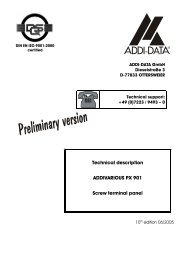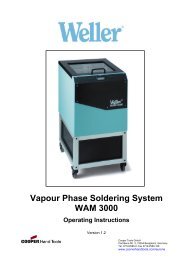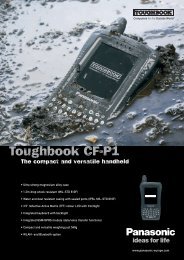CompuScope SDK Manua.. - Egmont Instruments
CompuScope SDK Manua.. - Egmont Instruments
CompuScope SDK Manua.. - Egmont Instruments
Create successful ePaper yourself
Turn your PDF publications into a flip-book with our unique Google optimized e-Paper software.
Mega Bytes/second (MB/s). The overhead time includes such constants as the trigger re-arm time and thePCI transfer setup time. The overhead time varies for different <strong>CompuScope</strong> models and is higher in aWindows environment compared to under DOS because of additional subroutine call overhead.As an example, let us assume that a user who must capture rapidly repeating triggers with an 8 bit PCI<strong>CompuScope</strong> 82G and wants to know the maximum achievable PRF. Assume further that the user mustcapture 25 µs records in single channel mode at a 2 GS/s sampling rate. In a Windows environment, Gageengineers have shown that, for single channel acquisition, the CS82G is able to sustain a PCI bus–mastering transfer rate of up to 80 MB/s. The overhead time for the CS82G in single channel acquisitionmode in a Windows environment is about 200 µs (about 50 µs of which, for instance, is the time requiredto set up the PCI bus-mastering data transfer).For this example, therefore, the PRF calculation is:CAPTURE TIME = 25µs [ 2000 MS/s × 25µs = 50000 samples ]+ TRANSFER TIME = 625 µs [ 50000 Samples × (1 channel) × (1 Byte/Sample)/(80 MB/s) ]+ OVERHEAD TIME = 200µsMINIMUM PRI = 850 µsSo, the MAXIMUM PRF = 1/ MINIMUM PRI = 1/850 µs ≈ 1.2 kHzSo the customer should be able do repetitive capture under the stated conditions at a PRF of up to 1.2 kHz.The above calculation makes three assumptions.First, we have assumed that the user’s PC has a PCI bus that can sustain an 80 MB/s data transfer rate.Some older desktop PCs could only sustain a 50 MB/s PCI transfer. <strong>CompuScope</strong>s will operate correctlyin such a PC, but the data transfer rate will be bottlenecked by the capability of the PC. Most of today’sPCs can sustain PCI transfer rates of up to 100 MB/s.Secondly, we have assumed that the user wants to transfer the total post-trigger depth to PC RAM.Consequently, the number of Samples used in the capture time and transfer time calculations are the same.This need not be the case and the user may have needed, for example, to transfer only the last 5µs of the25µs capture. In this case, only 10,000 samples would have been used for the transfer rate calculation.Alternatively, the user may have wanted to transfer 25µs of pre-trigger data in addition to the all of thepost-trigger data. In this case, 100,000 samples would have been used for the transfer rate calculation.Finally, we have assumed that data records are only transferred to PC RAM, where they are accumulated ina large buffer that can be manipulated after the repetitive capture sequence ends. Any additional operationsthat are performed during the acquisition sequence such as data analysis, display or disk storage must beincorporated into the above calculation.Gage engineers have performed extensive PRF benchmarks on <strong>CompuScope</strong> cards. The graph belowshows the results of a PRF benchmark measurement on a <strong>CompuScope</strong> 82G operating under Windows NTin a 600 MHz Pentium III with 128 MB of PC RAM. A PRF benchmark software utility rapidly acquiredmany records and accumulated the transferred data in PC RAM. No operations were performed on the dataduring the acquisition sequence and no non-essential Windows processes were active while the PRFbenchmark program was operating. Furthermore, the benchmark program used thegage_init_clock/gage_get_data code sequence, rather than gage_start_capture in order to startacquisition for best performance. (See Starting an Acquisition in Chapter 0). Also, the programmaintained the power to ADC circuitry ON throughout the acquisition sequence for best performance. (Seethe Appendix: <strong>CompuScope</strong> Power Management).The calculation above suggested that the CS82G can capture 50,000 Sample records at 2 GS/s in singlechannel mode with a PRF of about 1.2 kHz. This value of 1.2 kHz is very consistent with the curve shownbelow for single channel acquisition. At very low capture depths, the PRF is limited by the overhead timeof 200µs. In fact, the overhead time can be defined as the PRF obtainable for the capture and transfer ofzero samples. The overhead time, therefore puts an absolute upper limit on the maximum PRF of 1/200µs= 5 kHz for the CS82G in single channel mode. This 5 kHz maximum PRF is consistent with the low<strong>CompuScope</strong> <strong>SDK</strong> <strong>Manua</strong>l Page 23



